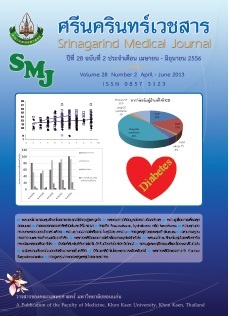Prevalence of Impaired Fasting Glucose and Type 2 Diabetes in Adolescence and Young Adults in Rural Thailand
คำสำคัญ:
Impaired fasting glucose, diabetes, Thailandบทคัดย่อ
Objective: To determine the prevalence of impaired fasting glucose (IFG) and diabetes (DM) in young rural Thai adults.
Material and Method: The study was designed as a cross-sectional investigation of 474 rural Thai adults aged between 14 and 35 years in both sexes. Fasting plasma glucose was measured and repeated if the first measurement was greater than 126 mg/dl. IFG and DM were diagnosed according to the American Diabetes Association’s (ADA) criteria.
Results: The respective overall prevalence of IFG and DM was 4.0% (19/474) and 1.3% (6/474); higher among men than women although the difference was not statistically significant. There was also no statistically significant difference in the prevalence of IFG and DM between obese and non-obese subjects. Advancing age was significantly associated with IFG for both sexes: each 1-year increase in age was associated with a respective 1.29-fold (95% CI: 1.05 to 1.60), 1.20-fold (95% CI: 0.91 to 1.58) and 1.39-fold (95% CI: 1.02 to 1.91), increase in the risk of IFG for all subjects, men and women. The diabetic risk was not, however, associated with age. We found no association between sex and BMI (body mass index) for developing IFG and DM.
Conclusion: The prevalence of IFG and DM among rural Thai adults is trending upward. These estimates have important implications for public health because of the high rate of conversion from IFG level to type 2 DM among adults. As the pace of urbanization continues or accelerates, the prevalence of IFG and DM will likely escalate.
Keywords: Impaired fasting glucose, diabetes, Thailand




